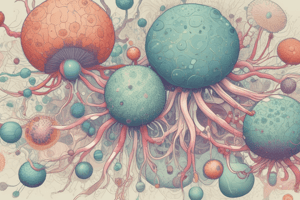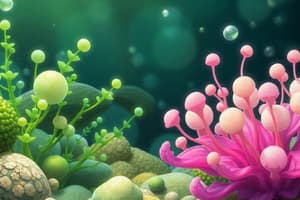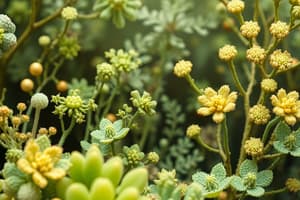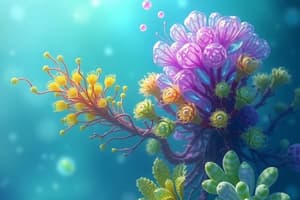Podcast
Questions and Answers
What method of reproduction do multicellular algae NOT use?
What method of reproduction do multicellular algae NOT use?
- Asexual reproduction through fragmentation
- Spores produced and dispersed by the parent
- Budding from a parent organism (correct)
- Sexual reproduction involving gametes
Which of the following describes the role of algae in coastal ecosystems?
Which of the following describes the role of algae in coastal ecosystems?
- They primarily act as producers of biofuel only.
- They exclusively absorb carbon dioxide.
- They compete with fish for food resources.
- They provide habitats and shelter for marine life. (correct)
What are alginates used for?
What are alginates used for?
- Animal feed production only
- Food flavoring only
- Pharmaceuticals and cosmetics (correct)
- Industrial brewing exclusively
How do life cycles in multicellular algae typically vary?
How do life cycles in multicellular algae typically vary?
Which factor does NOT pose a threat to marine algal communities?
Which factor does NOT pose a threat to marine algal communities?
Which economic use is NOT associated with certain species of algae?
Which economic use is NOT associated with certain species of algae?
In which phase do multicellular algae alternate in their life cycles?
In which phase do multicellular algae alternate in their life cycles?
What is a major consequence of habitat destruction for algae?
What is a major consequence of habitat destruction for algae?
What is the primary role of multicellular algae in marine ecosystems?
What is the primary role of multicellular algae in marine ecosystems?
Which pigment is characteristic of red algae (Rhodophyta)?
Which pigment is characteristic of red algae (Rhodophyta)?
What is one of the adaptations that multicellular algae have developed for survival in aquatic environments?
What is one of the adaptations that multicellular algae have developed for survival in aquatic environments?
Which group of algae is known for usually being larger and more complex than green algae?
Which group of algae is known for usually being larger and more complex than green algae?
How do golden algae (Chrysophyta) obtain their distinct coloration?
How do golden algae (Chrysophyta) obtain their distinct coloration?
What structural component of some multicellular algae helps them anchor to substrates?
What structural component of some multicellular algae helps them anchor to substrates?
What is one of the key distinctions between multicellular algae and true plants?
What is one of the key distinctions between multicellular algae and true plants?
In which environments can green algae (Chlorophyta) be found?
In which environments can green algae (Chlorophyta) be found?
Flashcards
Algae and Water Quality
Algae and Water Quality
Algae play a vital role in maintaining healthy water quality through oxygen production and absorbing carbon dioxide. They are similar to plants in this regard.
Algae in Coastal Ecosystems
Algae in Coastal Ecosystems
Algae are essential for coastal ecosystems. They provide habitats and shelter for marine life, contributing to biodiversity and ecological balance.
Human Uses of Algae
Human Uses of Algae
Some algae are directly harvested by humans as food or for various products.
Reproduction in Algae
Reproduction in Algae
Signup and view all the flashcards
Algae Life Cycles
Algae Life Cycles
Signup and view all the flashcards
Threats to Algae
Threats to Algae
Signup and view all the flashcards
Conservation of Algae
Conservation of Algae
Signup and view all the flashcards
Algae and Biofuel
Algae and Biofuel
Signup and view all the flashcards
What are multicellular algae?
What are multicellular algae?
Signup and view all the flashcards
What is the ecological significance of multicellular algae?
What is the ecological significance of multicellular algae?
Signup and view all the flashcards
What are characteristics of Red Algae?
What are characteristics of Red Algae?
Signup and view all the flashcards
What are characteristics of Green Algae?
What are characteristics of Green Algae?
Signup and view all the flashcards
What are characteristics of Brown Algae?
What are characteristics of Brown Algae?
Signup and view all the flashcards
What are characteristics of Golden Algae?
What are characteristics of Golden Algae?
Signup and view all the flashcards
How do multicellular algae adapt to their environment?
How do multicellular algae adapt to their environment?
Signup and view all the flashcards
What are some examples of structural adaptations in multicellular algae?
What are some examples of structural adaptations in multicellular algae?
Signup and view all the flashcards
Study Notes
Introduction
- Multicellular algae are eukaryotic organisms belonging to distinct kingdoms, often misclassified as plants.
- They are photosynthetic autotrophs, producing their own food through photosynthesis.
- They are vital in marine ecosystems, forming the base of the food web as primary producers.
- They exhibit a wide variety of forms, from simple filaments to complex structures resembling plants.
Types of Multicellular Algae
- Different algal groups possess unique structural features and pigments.
- Examples include:
- Red Algae (Rhodophyta): Characterized by phycoerythrin, a red pigment enabling deeper-water survival. They have complex life cycles and form large, intricate structures, sometimes with calcium carbonate components.
- Green Algae (Chlorophyta): Contain chlorophylls a and b, similar to land plants, inhabiting both marine and freshwater environments. Their forms vary widely.
- Brown Algae (Phaeophyta): Characterized by fucoxanthin, a brown pigment, and are often large and complex, commonly found in intertidal zones.
- Golden Algae (Chrysophyta): Contain chlorophylls and carotenoids, giving them a golden or brown coloration. They often form colonies and exhibit diverse cell shapes.
Characteristics and Adaptations
- Multicellular algae exhibit diverse adaptations for survival in aquatic environments.
- Many have specialized cells and tissue organization for efficient water uptake, nutrient absorption, and gas exchange.
- Some develop holdfasts to anchor to substrates.
- Others create floats for buoyancy to maintain optimal light levels.
- Photosynthetic mechanisms are modified for specific light and nutrient conditions.
- Cells may specialize in photosynthesis or other functions.
Ecological Significance
- Multicellular algae are primary producers, converting light energy into organic matter, forming a base for the aquatic food web.
- They support various consumers, from microscopic zooplankton to large fish.
- They improve water quality through oxygen production and carbon dioxide absorption.
- Some are harvested for food or other products.
- They are vital in maintaining coastal ecosystems, acting as habitats and providing shelter for marine life.
Economic Importance
- Some species are used as food sources.
- Others yield products like agar and carrageenan (food and industry).
- Alginates (pharmaceuticals and cosmetics) are derived from specific species.
- Their biomass offers potential for biofuel production.
Reproduction in Multicellular Algae
- Multicellular algae reproduce both asexually and sexually, tailored to the species' needs.
- Asexual reproduction includes fragmentation (new individuals from fragments) or spore production (dispersed offspring).
- Sexual reproduction involves fusion of gametes leading to zygote formation and new individual development tailored to the species.
Life Cycles in Multicellular Algae
- Algal life cycles vary greatly, from simple to complex within different groups.
- Structures and developmental stages differ among algal groups.
- Some exhibit alternation of generations, switching between haploid (one set of chromosomes) and diploid (two sets of chromosomes) phases.
Threats and Conservation
- Pollution (nutrient runoff, industrial discharge) affects algal populations.
- Habitat destruction and climate change threaten marine algal communities.
- Conservation efforts are essential for healthy aquatic ecosystems.
Studying That Suits You
Use AI to generate personalized quizzes and flashcards to suit your learning preferences.




